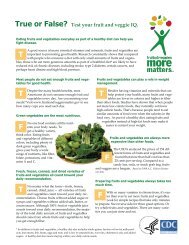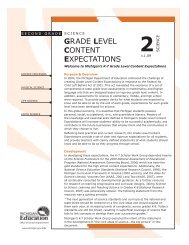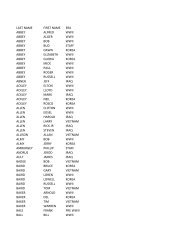Grade Level Content Expectations - State of Michigan
Grade Level Content Expectations - State of Michigan
Grade Level Content Expectations - State of Michigan
Create successful ePaper yourself
Turn your PDF publications into a flip-book with our unique Google optimized e-Paper software.
NUMBER AND<br />
OPERATIONS<br />
Understand and use number notation and place value<br />
N.ME.03.01 Read and write numbers to 10,000 in both numerals and words, and relate them<br />
to the quantities they represent, e.g., relate numeral or written word to a display <strong>of</strong> dots or<br />
objects.<br />
N.ME.03.02 Identify the place value <strong>of</strong> a digit in a number, e.g., in 3,241, 2 is in the hundreds<br />
place. Recognize and use expanded notation for numbers using place value through 9,999,<br />
e.g., 2,517 is 2000+ 500+10+ 7; 4 hundreds and 2 ones is 402.*<br />
N.ME.03.03 Compare and order numbers up to 10,000.<br />
Count in steps, and understand even and odd numbers<br />
N.ME.03.04 Count orally by 6’s, 7’s, 8’s, and 9’s starting with 0, making the connection<br />
between repeated addition and multiplication.<br />
N.ME.03.05 Know that even numbers end in 0, 2, 4, 6,or 8; name a whole number quantity<br />
that can be shared in two equal groups or grouped into pairs with no remainders; recognize<br />
even numbers as multiples <strong>of</strong> 2. Know that odd numbers end in 1, 3, 5, 7, or 9, and work with<br />
patterns involving even and odd numbers.<br />
Add and subtract whole numbers<br />
N.FL.03.06 Add and subtract fluently two numbers through 999 with regrouping and<br />
through 9,999 without regrouping.*<br />
N.FL.03.07 Estimate the sum and difference <strong>of</strong> two numbers with three digits (sums<br />
up to 1,000), and judge reasonableness <strong>of</strong> estimates.<br />
N.FL.03.08 Use mental strategies to fluently add and subtract two-digit numbers.<br />
Multiply and divide whole numbers<br />
N.MR.03.09 Use multiplication and division fact families to understand the inverse<br />
relationship <strong>of</strong> these two operations, e.g., because 3 x 8 = 24, we know that 24 ÷ 8 = 3<br />
or 24 ÷ 3 = 8; express a multiplication statement as an equivalent division statement.<br />
N.MR.03.10 Recognize situations that can be solved using multiplication and division including<br />
finding “How many groups” and “How many in a group” and write mathematical statements<br />
to represent those situations.*<br />
N.FL.03.11 Find products fluently up to 10 x 10; find related quotients using multiplication<br />
and division relationships.<br />
N.MR.03.12 Find solutions to open sentences, such as 7 x ■ = 42 or 12 ÷ ■ = 4, using the<br />
inverse relationship between multiplication and division.<br />
N.FL.03.13 Mentally calculate simple products and quotients up to a three-digit number by a<br />
one-digit number involving multiples <strong>of</strong> 10, e.g., 500 x 6, or 400 ÷ 8.<br />
N.MR.03.14 Solve division problems involving remainders, viewing the remainder as the “number<br />
left over”; interpret based on problem context, e.g. , when we have 25 children with 4 children per<br />
group then there are 6 groups with 1 child left over.*<br />
*revised expectations in italics<br />
M I C H I G A N D E P A R T M E N T O F E D U C A T I O N ■ v. 1 2 . 0 5 ■ M A T H E M A T I C S T H I R D G R A D E 3






